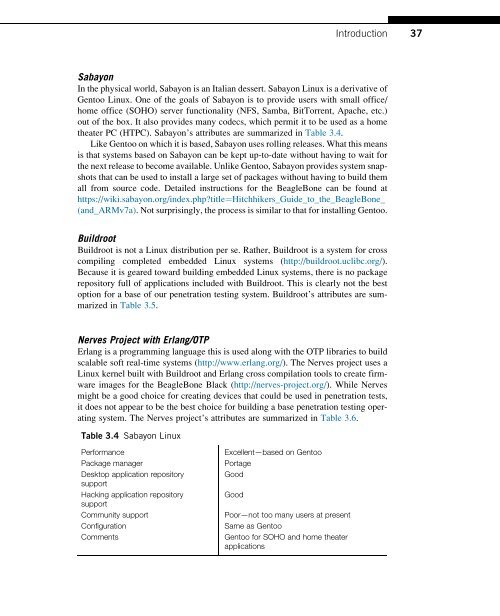Hacking_and_Penetration_Testing_with_Low_Power_Devices
You also want an ePaper? Increase the reach of your titles
YUMPU automatically turns print PDFs into web optimized ePapers that Google loves.
Introduction<br />
37<br />
Sabayon<br />
In the physical world, Sabayon is an Italian dessert. Sabayon Linux is a derivative of<br />
Gentoo Linux. One of the goals of Sabayon is to provide users <strong>with</strong> small office/<br />
home office (SOHO) server functionality (NFS, Samba, BitTorrent, Apache, etc.)<br />
out of the box. It also provides many codecs, which permit it to be used as a home<br />
theater PC (HTPC). Sabayon’s attributes are summarized in Table 3.4.<br />
Like Gentoo on which it is based, Sabayon uses rolling releases. What this means<br />
is that systems based on Sabayon can be kept up-to-date <strong>with</strong>out having to wait for<br />
the next release to become available. Unlike Gentoo, Sabayon provides system snapshots<br />
that can be used to install a large set of packages <strong>with</strong>out having to build them<br />
all from source code. Detailed instructions for the BeagleBone can be found at<br />
https://wiki.sabayon.org/index.php?title¼Hitchhikers_Guide_to_the_BeagleBone_<br />
(<strong>and</strong>_ARMv7a). Not surprisingly, the process is similar to that for installing Gentoo.<br />
Buildroot<br />
Buildroot is not a Linux distribution per se. Rather, Buildroot is a system for cross<br />
compiling completed embedded Linux systems (http://buildroot.uclibc.org/).<br />
Because it is geared toward building embedded Linux systems, there is no package<br />
repository full of applications included <strong>with</strong> Buildroot. This is clearly not the best<br />
option for a base of our penetration testing system. Buildroot’s attributes are summarized<br />
in Table 3.5.<br />
Nerves Project <strong>with</strong> Erlang/OTP<br />
Erlang is a programming language this is used along <strong>with</strong> the OTP libraries to build<br />
scalable soft real-time systems (http://www.erlang.org/). The Nerves project uses a<br />
Linux kernel built <strong>with</strong> Buildroot <strong>and</strong> Erlang cross compilation tools to create firmware<br />
images for the BeagleBone Black (http://nerves-project.org/). While Nerves<br />
might be a good choice for creating devices that could be used in penetration tests,<br />
it does not appear to be the best choice for building a base penetration testing operating<br />
system. The Nerves project’s attributes are summarized in Table 3.6.<br />
Table 3.4 Sabayon Linux<br />
Performance<br />
Package manager<br />
Desktop application repository<br />
support<br />
<strong>Hacking</strong> application repository<br />
support<br />
Community support<br />
Configuration<br />
Comments<br />
Excellent—based on Gentoo<br />
Portage<br />
Good<br />
Good<br />
Poor—not too many users at present<br />
Same as Gentoo<br />
Gentoo for SOHO <strong>and</strong> home theater<br />
applications


